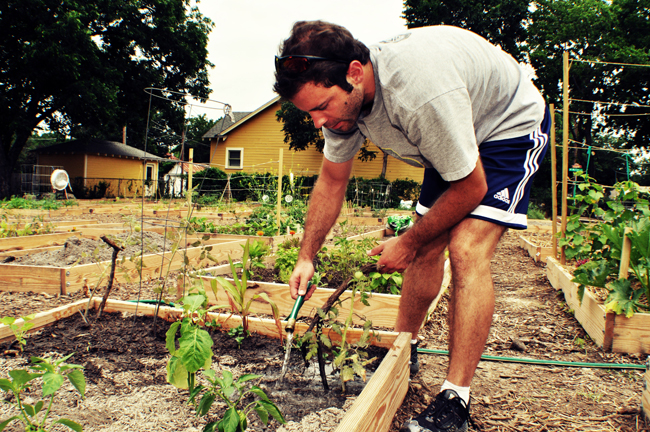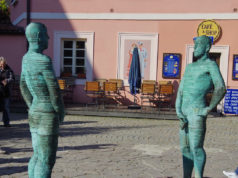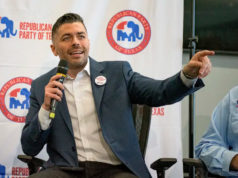The idea of turning a city’s unused green space into urban gardens has been slow in coming to Fort Worth compared to the rest of the country — inner-city gardens have been part of the New York City landscape since 1976, for instance. But the worm — or, in this case, the sod — may finally have turned in Cowtown, judging by what is going on over in the Fairmount neighborhood, in plots around town owned by a faith-based organization, and in an ambitious plan to sell urban-garden-grown food at the old Public Market building.

Project-44, a nonprofit organization supported by more than a dozen churches of various denominations as well as individuals, has been offering plots of land to needy people to lease for growing vegetables since 2008. The only stipulation is that a portion of the harvest must be donated to local food banks. The land and equipment are donated, and volunteers help with the planting and gathering. They “have lots plowed and planted all over Fort Worth,” said local entrepreneur Johndavid Bartlett, who is partnering with the group to not only share but sell locally grown produce. Bartlett, a well-known local chef, said Project-44 has also been given 55 acres and a greenhouse at the edge of Granbury for its gardening work.
Bartlett’s latest endeavor is called the New Public Market. He calls it a “community-owned business,” modeled somewhat after old-fashioned food co-ops. That business is separate from — but, he hopes, related to — the beautiful old art-deco Fort Worth Public Market building at Henderson Street and I-30, which he hopes to be able to lease, renovate, and return to its original use, as a market space for locally produced foods.
He said 100 “friends and supporters” have invested in the New Public Market concept. “Part of what we are doing,” he wrote in an e-mail, is trying to “create a new system of producing, gathering, and distributing local, sustainable food products [by] nurturing urban gardens and farms. … We hope to create a new urban agriculture system for Fort Worth.”
The group held its first market day a few weeks ago in the parking lot of outdoor furnishings retailer Into the Garden. The only Texas-grown produce sold that day was from the wholesale market in Dallas, but Texas-made cheeses, breads, pastries, and sauces were also available (along with free compost, free vegetable seeds, and live music). Bartlett said it was a “raging success” and explained, “As the harvests [around Fort Worth] increase, we will have local organic and sustainable farms with their own booths.”
Over on the Near South Side a few weeks ago, there was no talk of selling homegrown produce, only of serving it up from gardeners’ own tables. More than 100 people showed up to celebrate the opening of the Fairmount Community Garden. Susan Harper, garden manager and organizer, called it “a true community garden” and a “dream come true.”
“This is the first [public garden] of its kind in Fort Worth,” said an obviously pleased Joel Burns, the area’s city councilman, who is credited with cutting through a wad of red tape to make the dream possible. The garden covers two city-owned lots on Fifth Avenue a few blocks south of Magnolia Avenue and across the street from a small neighborhood park. The 75 plots, each 8′ x 4′, are available to neighborhood residents for an annual fee of $35. Nearly all are taken, including the six set aside for nonprofit groups and low-income residents.
Community gardens have been successful in mostly poor areas of big cities for decades. First Lady Michelle Obama brought the idea into the national limelight when she and a slew of Washington, D.C., schoolchildren planted a kitchen garden on the grounds of the White House shortly after her husband took office.
According to Harper, the Fairmount garden idea was “birthed” by Andy Schoolmaster, a dean in the TCU College of Liberal Arts and director of the TCU Urban Institute, who then took it to Paul Paine, president of Fort Worth South, who “nurtured it” along with Harper, over the past two years.
“They backed the idea up with grants to help make it possible,” Harper said. The nonprofit community garden association is operating under the umbrella of the Fairmount Neighborhood Association while it waits for its own nonprofit status to be approved, but already the garden group has received three $1,000 grants to pay the first year’s insurance liability premiums, among other expenses. A grant proposal written by neighborhood resident Rose Bradshaw brought in $2,500 from Home Depot for the materials for the raised beds.
Harper said that Burns “probably thought I was crazy” when she first went to him with the idea, but he quickly signed on. He “went above and beyond to find the land and steered me to the people who could help us obtain the use of the property” that the city had taken years ago in a tax foreclosure, she said. A special lease was developed by the city’s legal department. The Fairmount group leases the two lots for one dollar a year under that agreement, one that is specific to public uses. City council approval was required, since the city cannot ordinarily lease land taken in tax foreclosures.
“We have set new city policy with this,” Burns said. The group and its supporters had to overcome liability issues (the nonprofit group must carry insurance) as well as dealing with urban forestry regulations.
A number of trees had to be cleared off the long-vacant lots along the fence lines in order to provide space and sun — but that meant the group had to comply with the city’s tree regulations. They did so with the volunteer help of Sam Himmelhaver, a local architect. There was some consternation among the group’s environmentalists, who initially objected to tree removals but relented after a compromise was reached that left several old-growth pecan trees standing. One resident said the trees removed were invasive, not native, species.
The major part of the work that finally brought it all together, however, was accomplished by the residents themselves. Harper said the gardeners worked every weekend, rain or shine, clearing the lots, designing the beds, constructing them, filling them with soil, and building the fences. A number of area businesses donated materials and labor. Construction company owner Joe Frank sent his crew to remove large tree stumps, then filled and graded the lots for drainage. Plumbing contractor Don Forman laid the water lines; plumbing supply employees Haylee Frix and Davin Pyles provided all of the plumbing hardware; lumber company owner Lonnie Goolsby donated the cedar for the perimeter fences; and a local composting company owner, Joel Simpson, gave the project heavily discounted pricing on the soil to fill the beds.
It was “a community project from start to finish,” Burns said.
As Burns was getting ready to leave the garden for another meeting, neighborhood resident Mark Troxler stopped to thank him for helping to make the garden possible.
“I grew up in a gardening family,” Troxler said, “and I really miss not having room for a garden — but now I do.” He showed his receipt for the bed he had just leased. What would he plant? “Peppers, lots of peppers. I really love peppers,” he said, as he jumped on his bicycle and rode off.
By summer Troxler should have his peppers, and others should have tomatoes to pick, cucumbers to pickle, green beans to snap, sweet cantaloupe for breakfast, and maybe an ear of corn or two.
The Fairmount gardeners and residents talked about the sense of community that is growing among the gardeners, along with the vegetables.
“This is bringing us together like living in a small town once did,” one said. “We have become real neighbors. Now, as we care for our gardens, we know and care for each other.”











